Xerox 2400
Xerox first duplicator was the 2400. This machine came on the market in october 1964. "2400" denoted the number of prints produced in an hour (40 copies in a minute). Although still some way short of offset speeds, this machine introduced the industry's first Automatic Document Feeder, Slitter/Perforator, and Collator (sorter)
| IMAGES |
TV commercial of the 2400
| SPECIFICATIONS | |
|---|---|
| Copy speed (per minute) | 40 |
| Paper tray | 2000 sheets |
| Output tray capacity | n/a |
| Finisher/sorter | 20 bins sorter in the standard version of 3600. Three further 10-bins modules can be added. |
| Staple function |  |
| Reduction/zoom |  |
| Document handler |  |
| Dimension and weight | |
| Length | 170 (cm) / 67 (inches) |
| Width | 78 (cm) / 31 (inches) |
| Height | 116 (cm) / 46 (inches) |
| Weight | 498 (K grams) / 1100 (Lbs) |
| Floor space requirements | 3.2 x 2.3 (meters) / 10.5 x 7.5 (feet) |
Do you have any more information about this model, or have brochures / pictures? Please leave a reply in the form below, or send an email to xeroxnostalgia@outlook.com


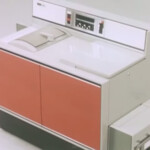
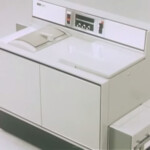
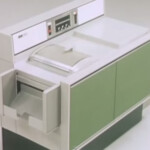
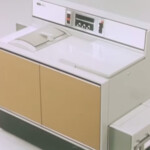
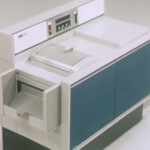
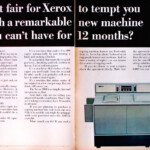
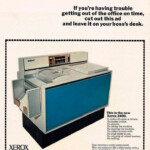


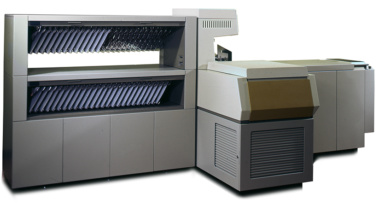
Anyone know why this model had a domed glass platen instead of a flat one?
I am thinking it had to do with the image on the glass being capture by a mirror that would rotate and put the image on the also round Selenium drum through an aperture plate. So I am assuming the scanning mirror would scan off the curved glass to keep it all in focus?
As an addendum to the comment I just now posted, I was surprised to learn, just after posting, that the day I colorized the 2400 photo was exactly 15 years ago today. The date of the Photoshop image file is July 11, 2005. That’s almost scary. This page turned up as I was looking to find how many reams of paper the 2400 could hold; to add to a comment on a thread on another website. Twilight Zone time.
The company for which my Dad was Office Manager had first leased a Xerox 914, introduced in 1959 as the first plain paper copier, with an output of a whopping seven copies per minute. The office upgraded to the 2400 shortly after its introduction in 1964. A couple of years later, at age 16, I was hired as Office Boy (handling mail, copies, blueprints, etc.) and eventually became the “Key Operator.” A lifelong geek, even at that age, I found this machine to be a masterpiece of technology. The vacuum pickup paper feed alone was impressive. We had the need… Read more »
Hi Mike, Thanks for your interesting story, and the story behind your colorized 2400 that you fixed in order for Xerox to upload on their website. Great image restoration of the 2400! I “stole” it from Xerox (and you) to use on xeroxnostalgia.com, but hopes that’s ok. Your story of a Office boy and “Key Operator” has some resemblance to my own story. I’m also see myself as a geek, and I call it “Xerox geekery”. It all started when I was about 11-12 years old, and I was making some copies on a Xerox 4000 machine to my class… Read more »
Hi Eric. Thanks for your reply and cool story. I can’t say whether the remote start foot switch was an option offered by Xerox. I suppose the possibility exists that they could have provided it on special request. I remembered it – and the sound it made – vividly. It looked like this, with a cable attached, of course.
Thanks Mike for the picture of the remote start foot switch.
My pleasure. Do you have/are you interested in having the high-resolution colorized 2400 photo?
Yes, that would be great. Maybe you could email me the photo to xeroxnostalgia@outlook.com ?
2400 3600 best copiers to service very reliable and built like a tank
When I started in ’78 and got trained on the 9200, the funniest stories I heard from the old timers were related to toner explosions, flaming vacuum cleaners shooting across the floor, and one poor Afican American with the classic late ’60s Afro, who, on his first day, cleaning the brush housing with the machine on, got his hair on fire, and quit immediately. (Poor guy. Hopefully he stayed in tech some way.)
Well, I don’t even remember what brought me here, but I guess I’m going down a Xerox rathole now…
Started as a Tech Rep in ’72 on the 2400. On a machine tucked into a telephone switching room ( nobody figured office space for a duplicator then ), one guy did a great job of vacuuming out a backed up brush housing. Only he didn’t realize his vacuum bag had a tear in it.
Oh, as a side note, certain companies after market sold 2400/3600 and you could tell them as they had had parts of the aluminum frames broken and they had been welded back together, you could see it plainly. Interesting.
Ran these in Hollywood at a print shop that copied a lot of scripts, we had document feeders on them, there was an earlier version of the document feeder, and a later model. I learned how to do basic maintenance, change developer, polish/change drum, change lights etc etc etc. I remember those green fluorescent tubes made my skin crawl. Amazing machine, on board compressor for sheet pickup and fuser roll lifting.
2400 could not copy any solids, the developer was way too coarse/heavy.
Nixie tube copy counter rocked.
Great memories.
I was a Tech Rep for Xerox from 1971 to 2000. The 2400 was the first machine that I was trained on. Brian, you are right about the 2400/3600/7000 machines inability to reproduce solids. But the problem was actually in the fuser not the developer. If you were to crash the machine while in print, you could see that the solid image was reproduced on the drum. It was solid on the paper until it got to the fuser. When it passed through the fuser it caused the toner to squash out toward to edges leaving the center area lighter.… Read more »
I have just found this site for the first time and was puzzled to discover this entry giving a totally inaccurate explanation for the hollowing out of large solid areas on copies made by the 2400, 3600, 7000 etc. copiers. This effect had absolutely nothing to do with the fuser and absolutely everything to do with cascade development. You even stated that the image on the drum or copy is visibly solid throughout if you crash stopped the machine. Well this is simply not the case, crash stop the machine and both drum and unfused copy will display the same… Read more »
Hi Mike, The 3600III had the cascade development with a set curved bias plate for solids! Hopefully you had none in GB. I had 5 of them and don’t wish them on anyone. 20lb Co2 bottles, fish line, and radiant fuser…
CT, USA
Hi Peter, It sounds horrific. We never had different marks of 3600’s, just plain 3600’s, some of which were field conversions of the 2400. They all had bias plates on the dev tank, toner stuck to it and had to be scraped off with a steel rule, but the type you refer to would seem to be different. I was never trained on radiant fuser machines but occasionally did calls untrained on a 2202 desk top machine. When a bonfire started in the fuser the fishing line melted and the trap doors shut. I can’t imagine why RX adapted such… Read more »
Filling solids was first solved with the 4000 copier. The developer housing used up hill cascading to solve the filling solids problem.
I had at least 3 36III’s in my territory. The CO2 bottles were great for cooling kegs.
I worked at a NASA facility in 1966 and I remember when we got a 2400 used to provide copies of research papers to requestors. There was a “Key Operator” you had to call to fix paper jams or other problems. Only trained operators were allowed to use this fabulous new machine.
I worked as a dups. tech on 2400, 3600 and 7000’s from 1974 ti the late 1980’s
I worked at Westinghouse Nuclear for 23years. I started on an 1860,which did often catch fire,especially when using vellum paper. The cure was a rag over the heating elements to catch the vapors and then periodically change the rag.I still sometimes dream of running the old girl. Setting the cortrons so they glowed with a violet aurea. Mine was on disply at the Smithsonian for years. I had written on the frame the words “a scribe”. When I looked at the one at the Smithsonian I asked permission to open the top cover. There was my writing. I also ran… Read more »
I have seen various posts here about machines catching fire, by far the worst example of this I ever saw was an 1860 plan printer which worked off rolls burn a copy which fell into the collector-tray full of plans – the whole lot then caught fire and wrecked the machine and caused our manager to absolutely freak out!!……
I used to operate Xerox 1860s, 3600s, and 7000 in the early 70’s, while in my late teens. The latter two were real workhorses; the 1860 was quirky (to be charitable). Yes, it did have a propensity to jam and ignite paper that was caught in the fuser, which would necessitate removal and cleaning of the drum, at minimum (a somewhat delicate task). Then there were the corotrons….. Come to think of it, those needed to be replaced on the 7000 and 3600 as well, IIRC. We did a lot of our own maintenance on those machines, which tended to… Read more »
Speaking of fires, maybe you’re not aware of another machine Xerox introduced in the 70’s (I was trained on it but don’t remember when). It was the 3600III which was basically a 3600 but had a radiant fuser instead of the heat/pressure rollers. Xerox developed the radiant fuser because the 2400/3600/7000 could not reproduce solid areas. The problem was in the fuser. The image developed as a solid but when the paper passed through the heat & pressure rollers, the solid image would end up being dark on the edges and lighter in the center. With the radiant fuser, the… Read more »
You for got to list that you were also a dispatcher for the 9200 in 1975 .
The biggest problem with large solid areas was not development, or transfer, but the fusing. Those large black areas would stick to the fuser roll and jam. It’s why the 36II went to radiant fusing.
Changing the gearing was only part of the problem as in the US the copier was connected to a 60Hz 120v supply. To operate in the UK several electrical components needed changing, including the large choke for the 12 fluorescent exposure lamps, plus there were cam timing changes required.
I imported Xerox 2400 copiers from the USA to the UK in the early 80s and converted them to 3600 machines by changing numerous components including the main gearing. These along with the 7000 were the copier workhorse machines before the 9000 series were developed. I still have service manuals, circuit diagrams and promotional pamphlets for the Xerox 3600/7000 copiers.
Thanks for your reply. I did not know that this was done on Xerox machines, but this was perhaps also something that one did with other models too? The Xerox 2400 and 3600/7000 looked pretty similar, so maybe it was not too hard to modify these machines.
Hola Graham: Tendrias informacion del harware de las placas principales de los modelos 2600, 3100 y 3107. Tengo informacion de diagnostico de campo de diagnostico mecanico y de cableado electrico pero nada del hardware de las placas. Agradeceria informacion al respecto . Saludos
Hi Graham ( assuming that you are still around… )
I spent my main time in Manchester. Started in London 1965, Machester 67 and then left 78. Mainly worked on 2400/3600/7000 but did my last 2 years on the 9200. Would you be able to provide copies of both sides of the 3600 circuit diagram? High Res – maybe just HD smartphone. Happy to pay – PayPal? Be good to hear back.
Hi Kim (yes! … I’m still around)
Only just seen your post (it’s 2023 now) but I do have the 3600 schematic you requested. I would simply send them with no payment required.
Please contact me at – 124hp(at)gmx.com
The 7000 had plenty of electronics in it. I was a Rank Xerox engineer starting in the late 70’s till 2000. I think the 7000 had 8 printed circuit boards mounted in the consul. Also the programmer was solid state, the counters being nixie tubes. The complexity of the electronics varied depending if the mc had a scan wheel or a variocam reduction scan system, the variocam being more complex. The 2400 original programmer had valves (tubes) in it, but was modified to have a solid state programmer in it, in the uk this was called the UK 2 programmer.… Read more »
That is true, the computer form feeder was a big beast that liked to eat it’s contents, I also remember the whole machine being incredibly noisy, I worked for a Xerox copy shop in Birmingham for many years that used solely Rank Xerox kit.
I was also a Rank Xerox engineer from 68 to 71 in Mannheim Germany and then from 71 to 73 in Durban South Africa .
Still around in SA?
I do not remeber a document feed on this series; there was one that carried a web for export documentation and the tractor jobbie was the CFP with all transistor (-ve) logic – used a lot in London banks for their overnight balance runs printouts.
Hi,
I Used to work on a copy shop with 1 like in the picture but the one we
had was 7000, it was 100% analog no transistors whatsoever.
I learned how to service it just by looking, that was 1986-1988
cheers.
My high school had one of these that was still in service into the early 90’s (or it may have been a 3600, but I can’t find a picture of one without a sheet feeder, so it’s hard to say). I distinctly remember the curved glass and there being two “humps” on the top (so I know it wasn’t a 7000). It was a basic machine, no accessories. I recall it being a darker gray color (though I may be wrong, these all look lighter than I recall), possibly with the yellow front. I don’t recall exactly when they got… Read more »
That was quite amazing to know that they had this machine, in service into the mid 90’s. I have never seen this machine, but have seen the 3600 and the 7000, which is quite like the 2400. I think the 3600 was the only one with a document feeder. I don’t know if the 2400 and 7000 had document feeder?
the doors were orange on the 3600 grey on the 2400 and blue on the 3600 3